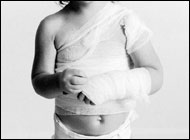Back-Over Injuries to Children Greater with Trucks, Minivans
Every year Utah children are seriously injured and killed when they’re hit by a vehicle backing out of a driveway. But a child is up to 2 1/2 times more likely to be backed over by a minivan or truck than by a car, according to a University of Utah study.
In the first report of its kind, University researchers found children are 2.4 times more likely to be struck by a van and 53 percent more likely to be hit by a truck than by a car. The study, conducted by the U’s Intermountain Injury Control Center, also found children hit by high-profile vehicles, such as trucks, SUVs or minivans, are more likely to require hospitalization, surgery, and treatment in an intensive care unit than children backed over by cars.
Previous reports have suggested high-profile vehicles produce a large blind spot behind them, but no studies in the United States have attempted to document the rate of injury by type of vehicle. The findings of this study will appear in the June 2006 issue of Pediatric Emergency Care.
The research also found Utah children are more likely to be backed over in residential driveways than children in other states. According to N. Clay Mann, Ph.D., the study’s lead investigator and director of research at the Intermountain Injury Control Research Center, the risk of injury may be increased because Utah has the highest number of persons per household and the youngest population of all 50 states, with nearly 33 percent of residents under the age of 18. “The popularity of ‘family-type’ SUVs, minivans and pickup trucks continues to increase in Utah, with one registered family-type vehicle for every 10 licensed drivers,” he said. 
The research shows the importance of educating parents and young children about dangers in the driveway and about establishing rules for safe play. Rear cameras and sensors are available to warn a driver that a child or other obstacle is behind a vehicle. “But there is no substitute for walking behind (or at least looking behind) your vehicle before getting in and putting the car in reverse,” Mann said.
The study, using medical records and police reports, collected back-over injury data for Utah children under age 10 from 1998 to 2003. The number of state-registered vehicles was used to determine if injuries were more common among certain types of vehicles.
University of Utah Health Sciences Center
Revision date: June 22, 2011
Last revised: by Amalia K. Gagarina, M.S., R.D.